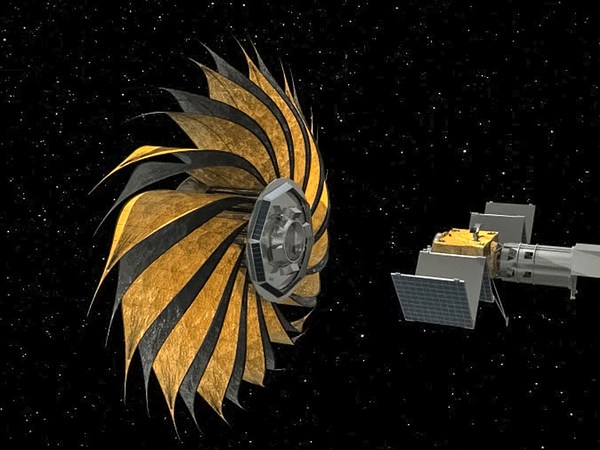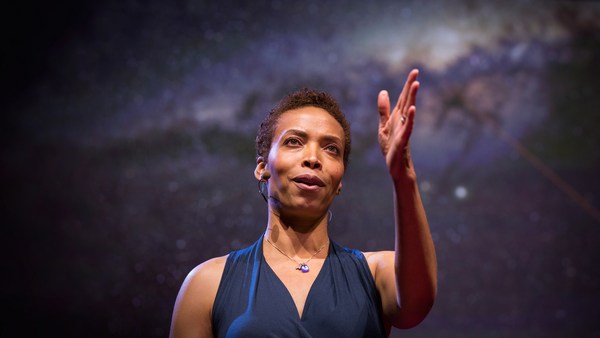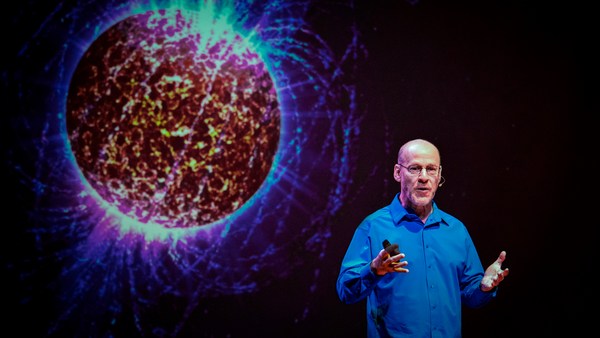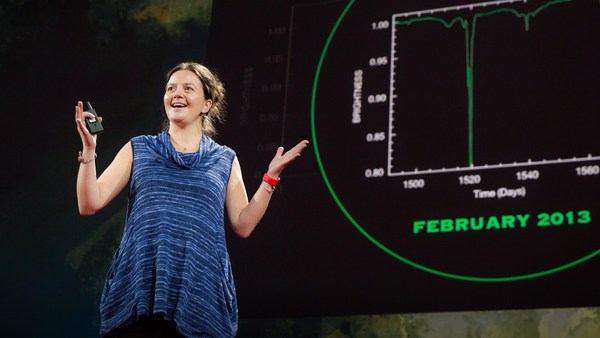I'm here to tell you about the real search for alien life. Not little green humanoids arriving in shiny UFOs, although that would be nice. But it's the search for planets orbiting stars far away.
Every star in our sky is a sun. And if our sun has planets -- Mercury, Venus, Earth, Mars, etc., surely those other stars should have planets also, and they do. And in the last two decades, astronomers have found thousands of exoplanets.
Our night sky is literally teeming with exoplanets. We know, statistically speaking, that every star has at least one planet. And in the search for planets, and in the future, planets that might be like Earth, we're able to help address some of the most amazing and mysterious questions that have faced humankind for centuries. Why are we here? Why does our universe exist? How did Earth form and evolve? How and why did life originate and populate our planet? The second question that we often think about is: Are we alone? Is there life out there? Who is out there? You know, this question has been around for thousands of years, since at least the time of the Greek philosophers. But I'm here to tell you just how close we're getting to finding out the answer to this question. It's the first time in human history that this really is within reach for us.
Now when I think about the possibilities for life out there, I think of the fact that our sun is but one of many stars. This is a photograph of a real galaxy, we think our Milky Way looks like this galaxy. It's a collection of bound stars. But our [sun] is one of hundreds of billions of stars and our galaxy is one of upwards of hundreds of billions of galaxies. Knowing that small planets are very common, you can just do the math. And there are just so many stars and so many planets out there, that surely, there must be life somewhere out there. Well, the biologists get furious with me for saying that, because we have absolutely no evidence for life beyond Earth yet.
Well, if we were able to look at our galaxy from the outside and zoom in to where our sun is, we see a real map of the stars. And the highlighted stars are those with known exoplanets. This is really just the tip of the iceberg. Here, this animation is zooming in onto our solar system. And you'll see here the planets as well as some spacecraft that are also orbiting our sun. Now if we can imagine going to the West Coast of North America, and looking out at the night sky, here's what we'd see on a spring night. And you can see the constellations overlaid and again, so many stars with planets. There's a special patch of the sky where we have thousands of planets.
This is where the Kepler Space Telescope focused for many years. Let's zoom in and look at one of the favorite exoplanets. This star is called Kepler-186f. It's a system of about five planets. And by the way, most of these exoplanets, we don't know too much about. We know their size, and their orbit and things like that. But there's a very special planet here called Kepler-186f. This planet is in a zone that is not too far from the star, so that the temperature may be just right for life. Here, the artist's conception is just zooming in and showing you what that planet might be like.
So, many people have this romantic notion of astronomers going to the telescope on a lonely mountaintop and looking at the spectacular night sky through a big telescope. But actually, we just work on our computers like everyone else, and we get our data by email or downloading from a database. So instead of coming here to tell you about the somewhat tedious nature of the data and data analysis and the complex computer models we make, I have a different way to try to explain to you some of the things that we're thinking about exoplanets.
Here's a travel poster: "Kepler-186f: Where the grass is always redder on the other side." That's because Kepler-186f orbits a red star, and we're just speculating that perhaps the plants there, if there is vegetation that does photosynthesis, it has different pigments and looks red. "Enjoy the gravity on HD 40307g, a Super-Earth." This planet is more massive than Earth and has a higher surface gravity. "Relax on Kepler-16b, where your shadow always has company." (Laughter) We know of a dozen planets that orbit two stars, and there's likely many more out there. If we could visit one of those planets, you literally would see two sunsets and have two shadows. So actually, science fiction got some things right. Tatooine from Star Wars. And I have a couple of other favorite exoplanets to tell you about. This one is Kepler-10b, it's a hot, hot planet. It orbits over 50 times closer to its star than our Earth does to our sun. And actually, it's so hot, we can't visit any of these planets, but if we could, we would melt long before we got there. We think the surface is hot enough to melt rock and has liquid lava lakes.
Gliese 1214b. This planet, we know the mass and the size and it has a fairly low density. It's somewhat warm. We actually don't know really anything about this planet, but one possibility is that it's a water world, like a scaled-up version of one of Jupiter's icy moons that might be 50 percent water by mass. And in this case, it would have a thick steam atmosphere overlaying an ocean, not of liquid water, but of an exotic form of water, a superfluid -- not quite a gas, not quite a liquid. And under that wouldn't be rock, but a form of high-pressure ice, like ice IX.
So out of all these planets out there, and the variety is just simply astonishing, we mostly want to find the planets that are Goldilocks planets, we call them. Not too big, not too small, not too hot, not too cold -- but just right for life. But to do that, we'd have to be able to look at the planet's atmosphere, because the atmosphere acts like a blanket trapping heat -- the greenhouse effect. We have to be able to assess the greenhouse gases on other planets. Well, science fiction got some things wrong. The Star Trek Enterprise had to travel vast distances at incredible speeds to orbit other planets so that First Officer Spock could analyze the atmosphere to see if the planet was habitable or if there were lifeforms there.
Well, we don't need to travel at warp speeds to see other planet atmospheres, although I don't want to dissuade any budding engineers from figuring out how to do that. We actually can and do study planet atmospheres from here, from Earth orbit. This is a picture, a photograph of the Hubble Space Telescope taken by the shuttle Atlantis as it was departing after the last human space flight to Hubble. They installed a new camera, actually, that we use for exoplanet atmospheres. And so far, we've been able to study dozens of exoplanet atmospheres, about six of them in great detail. But those are not small planets like Earth. They're big, hot planets that are easy to see. We're not ready, we don't have the right technology yet to study small exoplanets. But nevertheless, I wanted to try to explain to you how we study exoplanet atmospheres.
I want you to imagine, for a moment, a rainbow. And if we could look at this rainbow closely, we would see that some dark lines are missing. And here's our sun, the white light of our sun split up, not by raindrops, but by a spectrograph. And you can see all these dark, vertical lines. Some are very narrow, some are wide, some are shaded at the edges. And this is actually how astronomers have studied objects in the heavens, literally, for over a century. So here, each different atom and molecule has a special set of lines, a fingerprint, if you will. And that's how we study exoplanet atmospheres. And I'll just never forget when I started working on exoplanet atmospheres 20 years ago, how many people told me, "This will never happen. We'll never be able to study them. Why are you bothering?" And that's why I'm pleased to tell you about all the atmospheres studied now, and this is really a field of its own. So when it comes to other planets, other Earths, in the future when we can observe them, what kind of gases would we be looking for? Well, you know, our own Earth has oxygen in the atmosphere to 20 percent by volume. That's a lot of oxygen. But without plants and photosynthetic life, there would be no oxygen, virtually no oxygen in our atmosphere. So oxygen is here because of life. And our goal then is to look for gases in other planet atmospheres, gases that don't belong, that we might be able to attribute to life. But which molecules should we search for? I actually told you how diverse exoplanets are. We expect that to continue in the future when we find other Earths.
And that's one of the main things I'm working on now, I have a theory about this. It reminds me that nearly every day, I receive an email or emails from someone with a crazy theory about physics of gravity or cosmology or some such. So, please don't email me one of your crazy theories. (Laughter) Well, I had my own crazy theory. But, who does the MIT professor go to? Well, I emailed a Nobel Laureate in Physiology or Medicine and he said, "Sure, come and talk to me." So I brought my two biochemistry friends and we went to talk to him about our crazy theory. And that theory was that life produces all small molecules, so many molecules. Like, everything I could think of, but not being a chemist. Think about it: carbon dioxide, carbon monoxide, molecular hydrogen, molecular nitrogen, methane, methyl chloride -- so many gases. They also exist for other reasons, but just life even produces ozone. So we go to talk to him about this, and immediately, he shot down the theory. He found an example that didn't exist. So, we went back to the drawing board and we think we have found something very interesting in another field.
But back to exoplanets, the point is that life produces so many different types of gases, literally thousands of gases. And so what we're doing now is just trying to figure out on which types of exoplanets, which gases could be attributed to life. And so when it comes time when we find gases in exoplanet atmospheres that we won't know if they're being produced by intelligent aliens or by trees, or a swamp, or even just by simple, single-celled microbial life.
So working on the models and thinking about biochemistry, it's all well and good. But a really big challenge ahead of us is: how? How are we going to find these planets? There are actually many ways to find planets, several different ways. But the one that I'm most focused on is how can we open a gateway so that in the future, we can find hundreds of Earths. We have a real shot at finding signs of life. And actually, I just finished leading a two-year project in this very special phase of a concept we call the starshade. And the starshade is a very specially shaped screen and the goal is to fly that starshade so it blocks out the light of a star so that the telescope can see the planets directly. Here, you can see myself and two team members holding up one small part of the starshade. It's shaped like a giant flower, and this is one of the prototype petals. The concept is that a starshade and telescope could launch together, with the petals unfurling from the stowed position. The central truss would expand, with the petals snapping into place. Now, this has to be made very precisely, literally, the petals to microns and they have to deploy to millimeters. And this whole structure would have to fly tens of thousands of kilometers away from the telescope. It's about tens of meters in diameter. And the goal is to block out the starlight to incredible precision so that we'd be able to see the planets directly. And it has to be a very special shape, because of the physics of defraction. Now this is a real project that we worked on, literally, you would not believe how hard. Just so you believe it's not just in movie format, here's a real photograph of a second-generation starshade deployment test bed in the lab. And in this case, I just wanted you to know that that central truss has heritage left over from large radio deployables in space.
So after all of that hard work where we try to think of all the crazy gases that might be out there, and we build the very complicated space telescopes that might be out there, what are we going to find? Well, in the best case, we will find an image of another exo-Earth. Here is Earth as a pale blue dot. And this is actually a real photograph of Earth taken by the Voyager 1 spacecraft, four billion miles away. And that red light is just scattered light in the camera optics.
But what's so awesome to consider is that if there are intelligent aliens orbiting on a planet around a star near to us and they build complicated space telescopes of the kind that we're trying to build, all they'll see is this pale blue dot, a pinprick of light. And so sometimes, when I pause to think about my professional struggle and huge ambition, it's hard to think about that in contrast to the vastness of the universe. But nonetheless, I am devoting the rest of my life to finding another Earth.
And I can guarantee
that in the next generation of space telescopes, in the second generation, we will have the capability to find and identity other Earths. And the capability to split up the starlight so that we can look for gases and assess the greenhouse gases in the atmosphere, estimate the surface temperature, and look for signs of life.
But there's more. In this case of searching for other planets like Earth, we are making a new kind of map of the nearby stars and of the planets orbiting them, including [planets] that actually might be inhabitable by humans.
And so I envision that our descendants, hundreds of years from now, will embark on an interstellar journey to other worlds. And they will look back at all of us as the generation who first found the Earth-like worlds.
Thank you.
(Applause)
June Cohen: And I give you, for a question, Rosetta Mission Manager Fred Jansen.
Fred Jansen: You mentioned halfway through that the technology to actually look at the spectrum of an exoplanet like Earth is not there yet. When do you expect this will be there, and what's needed?
Actually, what we expect is what we call our next-generation Hubble telescope. And this is called the James Webb Space Telescope, and that will launch in 2018, and that's what we're going to do, we're going to look at a special kind of planet called transient exoplanets, and that will be our first shot at studying small planets for gases that might indicate the planet is habitable.
JC: I'm going to ask you one follow-up question, too, Sara, as the generalist. So I am really struck by the notion in your career of the opposition you faced, that when you began thinking about exoplanets, there was extreme skepticism in the scientific community that they existed, and you proved them wrong. What did it take to take that on?
SS: Well, the thing is that as scientists, we're supposed to be skeptical, because our job to make sure that what the other person is saying actually makes sense or not. But being a scientist, I think you've seen it from this session, it's like being an explorer. You have this immense curiosity, this stubbornness, this sort of resolute will that you will go forward no matter what other people say.
JC: I love that. Thank you, Sara.
(Applause)





